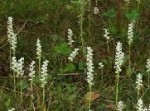 The name orchid conjures on images of exotic plants from foreign shores. Most of them are not suitable for the outdoor gardens in the United States but there are some noteworthy exceptions. North America has some beautiful native orchids that grow in cold areas as well as very warm ones. Some of these are easy to grow while others take more time and patience.
The name orchid conjures on images of exotic plants from foreign shores. Most of them are not suitable for the outdoor gardens in the United States but there are some noteworthy exceptions. North America has some beautiful native orchids that grow in cold areas as well as very warm ones. Some of these are easy to grow while others take more time and patience.
Here are five native orchids that would enhance any moist woodland garden.
 Grass Pink (Calopogon tuberosus)
Grass Pink (Calopogon tuberosus)
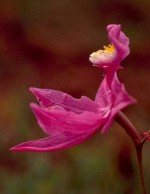 It is easy to miss this orchid entirely unless it is in bloom because its single long thin leaf blends in well with the grasses and sedges. In summer, however, 2-6 flowers will form on wiry stems and brighten the area with its vivid color. The generic name Calopogon is derived from Greek words meaning beautiful beard and refers to the tuft of yellow tipped white hairs on the upper petal of the flower. These hairs are false anthers and have evolved to trick bees that come to eat the pollen so that they will fertilize the flowers instead. Grass pink is a native of acid swamps, bogs, and wet meadows of eastern and central United States and Canada.
It is easy to miss this orchid entirely unless it is in bloom because its single long thin leaf blends in well with the grasses and sedges. In summer, however, 2-6 flowers will form on wiry stems and brighten the area with its vivid color. The generic name Calopogon is derived from Greek words meaning beautiful beard and refers to the tuft of yellow tipped white hairs on the upper petal of the flower. These hairs are false anthers and have evolved to trick bees that come to eat the pollen so that they will fertilize the flowers instead. Grass pink is a native of acid swamps, bogs, and wet meadows of eastern and central United States and Canada.
Color:
-
- Magenta to pink
Bloom Time:
-
- Summer
Size:
-
- 1-2’ H x .5’ W
Light:
-
- Sun-part sun
Soil:
-
- Moist to wet and boggy; acidic
Hardiness:
- Zones 3-10
 Snakemouth (Pogonia ophioglossoides)
Snakemouth (Pogonia ophioglossoides)
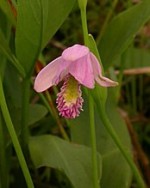 Also called rose pogonia, snakemouth’s more amusing common name comes from the belief that its scent resembles the breath of a snake. It makes its home in bogs and wet areas of Eastern United States from Newfoundland to Florida west to Minnesota and Texas. In early summer the diminutive plant sends up a single leaf and a straight stem that bears a leaf-like bract and a single flower. A branched brittle rhizome anchors the plant in boggy soil and can be divided with difficulty.
Also called rose pogonia, snakemouth’s more amusing common name comes from the belief that its scent resembles the breath of a snake. It makes its home in bogs and wet areas of Eastern United States from Newfoundland to Florida west to Minnesota and Texas. In early summer the diminutive plant sends up a single leaf and a straight stem that bears a leaf-like bract and a single flower. A branched brittle rhizome anchors the plant in boggy soil and can be divided with difficulty.
Color:
-
- Rose to hot pink
Bloom Time:
-
- Early summer
Size:
-
- 5-12” W x 6-12” W
Light:
-
- Sun to part sun
Soil:
-
- Wet, boggy, acidic
Hardiness:
- Zones 3-9
 Fragrant Lady’s Tresses (Spiranthes odorata)
Fragrant Lady’s Tresses (Spiranthes odorata)
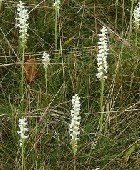 This native of estuaries and marshes along the coastal plain from Pennsylvania to Florida, produces a rosette of evergreen leaves and single stem topped with a raceme of tiny white flowers arranged like a spiral staircase. The flowers appear in the fall and have a strong vanilla fragrance. As the plants mature they send up root sprouts and may form substantial colonies where they are happy. Root sprouts can easily be used for propagation in spring.
This native of estuaries and marshes along the coastal plain from Pennsylvania to Florida, produces a rosette of evergreen leaves and single stem topped with a raceme of tiny white flowers arranged like a spiral staircase. The flowers appear in the fall and have a strong vanilla fragrance. As the plants mature they send up root sprouts and may form substantial colonies where they are happy. Root sprouts can easily be used for propagation in spring.
Color: White with green veins
Bloom Time: Late fall
Size: 1-2’ H x .5-12” W
Light: Sun to part sun
Soil: Moist to wet, acid
Hardiness: Zones 5-9
 Large Yellow Lady-Slipper (Cypripedium pubescens)
Large Yellow Lady-Slipper (Cypripedium pubescens)
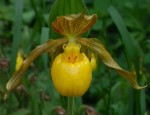 The large yellow lip pouches with their twisted sepals and petals give the flowers a whimsical look that endear them to all who see them. Native to rich woodlands from Nova Scotia to Maine and Minnesota south to Missouri, Alabama, and Georgia, they are one of the easiest wild orchid to grow.
The large yellow lip pouches with their twisted sepals and petals give the flowers a whimsical look that endear them to all who see them. Native to rich woodlands from Nova Scotia to Maine and Minnesota south to Missouri, Alabama, and Georgia, they are one of the easiest wild orchid to grow.
Color:
-
- Light to medium yellow lip with green to brown petals/sepals
Bloom Time:
-
- Late spring
Size:
-
- 12-18” H x 12-16” W
Light:
-
- Light shade
Soil:
-
- Moist, neutral
Hardiness:
- Zones 4-8
 Showy Lady-slipper (Cypripedium reginae)
Showy Lady-slipper (Cypripedium reginae)
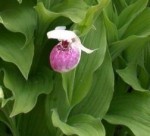 One of the most impressive native orchids is the showy lady-slipper, as the name implies. Its large flower is brightly colored and is complemented by silvery green leaves. A native of bogs and swamps in limestones areas in the East and Midwest, south to Georgia, this is a breathtaking beauty.
One of the most impressive native orchids is the showy lady-slipper, as the name implies. Its large flower is brightly colored and is complemented by silvery green leaves. A native of bogs and swamps in limestones areas in the East and Midwest, south to Georgia, this is a breathtaking beauty.
Color:
-
- Light to dark pink lip with white petals and sepals
Bloom Time:
-
- Late spring to early summer
Size:
-
- 14-28” H x 16-20” W
Light:
-
- At least 2-3 hours of direct sun in morning or late afternoon
Soil:
-
- Moist, neutral pH
Hardiness:
- Zones 3-8
These wild orchids are native to the eastern and middle United States but can be grown in other areas where their moisture requirements can be met. These five represent only a small number of the orchids that are native to the United States and each genus has more species of similar orchids. Some of these are endangered and all should be obtained from reliable nurseries that do not harvest their plants from the wild.
